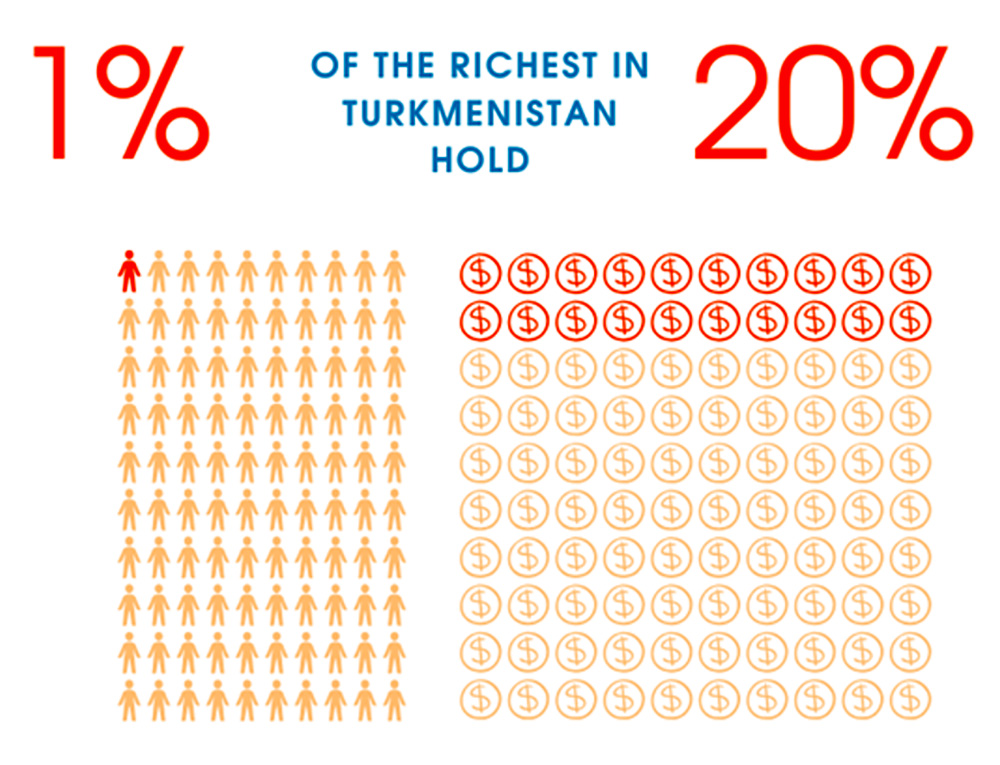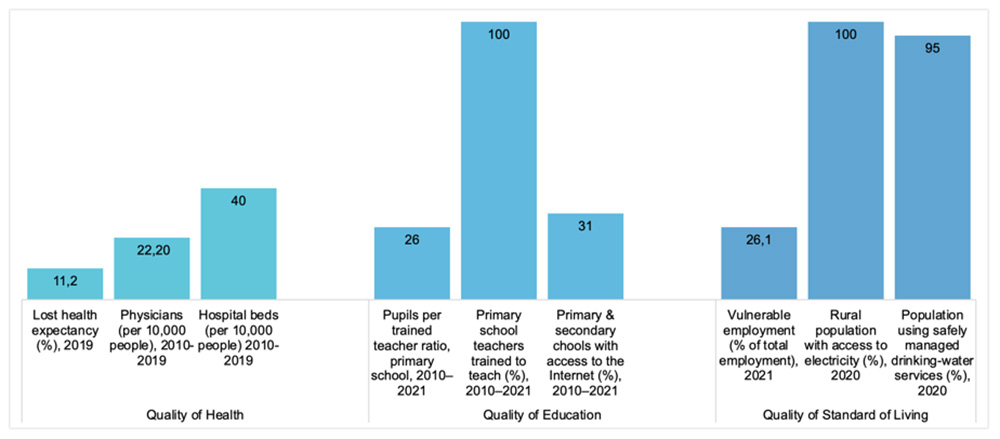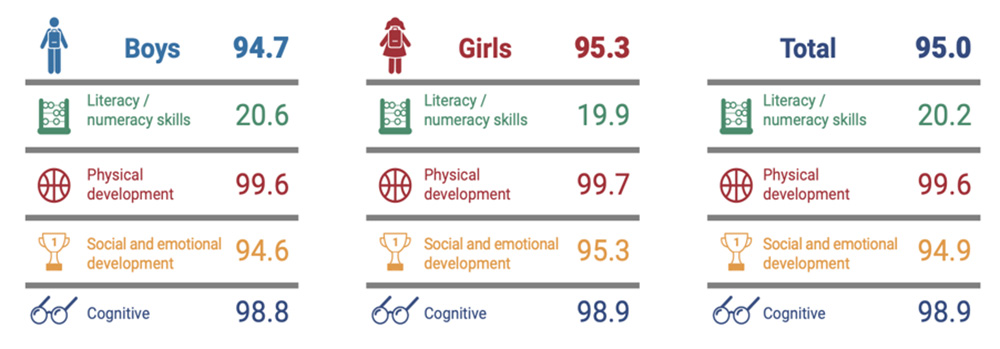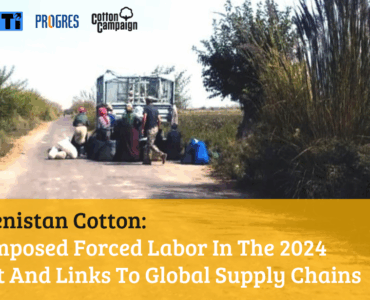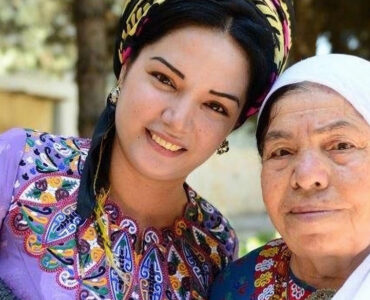Summary: Turkmenistan loses 16.9% of its human development due to inequalities which are mainly driven by inequalities in income and life expectancy. The richest 1% of the people in Turkmenistan hold 19.9% of the income. Due to low quality of healthcare people lose 11.2% of their health expectancy. The government policy of secrecy and denial drives infectious diseases underground and this prevents realistic assessment of the situation in the healthcare. Poor quality and limited access to early childhood and higher education inhibit children and young adults from developing important skills and accessing economic opportunities.
Turkmenistan ranks high on the Human Development Index (HDI). However, HDI is an average measure of basic human development and it conceals inequality in the distribution of human development across the population. This is why it is useful to look at inequality-adjusted HDI (IHDI) which takes into account inequality in – health, education and income. The difference between the HDI and IHDI represents the ‘loss in human development’ due to inequality and it is expressed as a percentage. As inequality in a country increase, the loss in human development also increases.
To get a balanced view on human development in Turkmenistan, information for this article comes from various international and national sources such as Human Development Reports from UNDP, Leaving No One Behind from UNESCAP, International Labour Organization, Doctors Without Borders, Global Datalab, BTI Transformation Index, Progres.Online, Turkmenistan Multiple Indicator Cluster Survey (MICS) 2019 and Voluntary National Reviews for Turkmenistan (2019, 2022).
The UN defines inequality of opportunity as unequal access to fundamental rights and services, required for individuals to sustain and improve their livelihoods. As illustrated in Figure 1, the coefficient of human inequality in Turkmenistan, which is an average for inequality in life expectancy, education, and income, is 16.4. Turkmenistan loses 16.9% of its human development due to inequalities, which is the biggest loss among Central Asian countries. Let’s examine what drives this inequality.
Figure 1. Inequality Adjusted Human Development Index (IHDI) for Central Asia, 2021
* Uzbekistan is excluded due to the lack of data.
Source: Human Development Reports.
The biggest inequality people in Turkmenistan experience is an income inequality which reflects uneven distribution of income throughout the population. To demonstrate, the richest 1% of the people in Turkmenistan hold 19.9% of the income. It is the highest income inequality in Central Asia. However, this might be even higher if we account for unofficial wealth that government officials accumulate through bribes. Income inequality results in lack of opportunities for better standards of living, stable financial futures, access to quality healthcare, education, employment among other things. It can predetermine someone’s future and affect the generations to come.
While the government increases salaries of public sector employees by 10% every year, this does not reflect the inflation in the country. For example, Palaw Index tracks food inflation by using the most popular Turkmen dish, palaw. The minimum wage in Turkmenistan increased from 870 TMT in 2020 to 957 TMT in 2021 while the portion of palaw a family could afford dropped from 13.2 to 10 portions. As illustrated in Figure 2, the largest share of total household expenses goes to food, which increased from 46.2% in 2018 to 52.9% in 2022. Given that this is a fairly high share, significant increases in food prices may increase the burden on household budgets. In comparison, in other upper middle income countries the share of household expenditure on food are as follows: Turkey – 27.3%, Russia – 29% and Belarus – 32.1% while the average in the EU is 14.3%.
Figure 2. The structure of household expenditures in Turkmenistan in 2018
Source: Government data, Voluntary National Review of Turkmenistan 2019.
Inequality in income is detrimental as it affects people’s ability to afford quality healthcare, take preventive measures and undergo costly lifesaving medical treatments. To illustrate, people in Turkmenistan experience 20% inequality in life expectancy, which is the highest level in Central Asia.
The smallest inequality people in Turkmenistan experience is in education. It is 2.9% which is the lowest level in Central Asia. This is primarily the result of free and compulsory secondary education, which is a legacy of the former Soviet Union. However, inequality appears in tertiary education where young people have to pay either the official tuition fee, bribe to get into university or both. At least 4 out of 5 university spots are filled with students who can afford paying bribes (up to several $10,000 per place) in addition to tuition fees. This is why out of 10 secondary school graduates only 3 are able to continue their education at vocational and higher education institutions in Turkmenistan. The country has some of the lowest numbers of people with higher education in the world. For every 10,000 citizens, there were only slightly more than 80 students in the 2020-2021 academic year. In comparison, even in 1989 there were 117 students.
Poverty limits equal access to basic resources and human development in Turkmenistan
In 2018 nearly 22% of people in Turkmenistan lived in poverty and an additional 5% lived in extreme poverty (below $1.90 a day). More recent data is available for the Multidimensional Poverty Index (MPI) for 2021, which examines each person’s overlapping deprivations across 10 indicators related to health, education, and standards of living. The index ranges from 0 to 1 where higher values imply higher multidimensional poverty. One needs to be critical when relying on this index as it is based on government statistics which is often criticized for being inaccurate. Nevertheless, it provides a small glimpse of the existing challenges in the country.
According to MPI for Turkmenistan, 0.2% of the population (or 16 thousand people) is multidimensionally poor and an additional 0.3% is vulnerable to multidimensional poverty (21 thousand people). Turkmenistan has the smallest share of people in Central Asia who are or at risk of being multidimensionally poor (see Figure 3).
Figure 3. Multidimensional Poverty in Central Asia, 2021
Source: Multidimensional Poverty Index.
Over 82% of multidimensional poverty in Turkmenistan is caused by deprivation in health and 15.5% is caused by losses in education. This highlights the importance of improving access to quality healthcare and education services, particularly for people from lower socioeconomic backgrounds. If people cannot access quality healthcare and education, this in turn will limit their chances of securing well-paid jobs and put them at a higher risk of falling into poverty. It can lead to a vicious cycle of poverty, also known as generational poverty, where one family after another will experience poverty if there is no appropriate policy intervention.
Figure 4. Percentage of the Multidimensional Poverty Index attributed to deprivations in each dimension
Source: Multidimensional Poverty Index.
Older people, who face a high risk of illnesses, are also at risk of falling into poverty. The social benefit levels in Turkmenistan remain below minimum adequacy standards. For example, in 2017 the level of non-contributory old-age pensions was set at 42.2% of the value of the national poverty line. This means the pension is not enough to prevent old-age poverty in Turkmenistan where older people, who rely on a social pension for their income, remain poor.
Poverty also limits people’s educational and economic opportunities. Household income, along with their place of residence, dictates people’s access to higher education making it difficult for youth from poor households to get a university degree. Only 3% of poorer individuals have completed tertiary education compared to 15% richer people. Given that access to full-time jobs depends on a person’s level of education, this may put individuals from poor families in a vicious cycle of poverty. The alleviation of poverty is not just about providing the means for survival but it is also about improving access to opportunity.
Low quality of healthcare, education and standard of living inhibit human development in Turkmenistan
The Quality of Human Development dashboard contains 14 indicators associated with the quality of health, education, and standard of living. Figure 5 summarizes some of the indicators available for Turkmenistan.
Donate to support Turkmen analysts, researchers and writers to produce factual, constructive and progressive content in their efforts to educate the public of Turkmenistan.
SUPPORT OUR WORKFigure 5. Quality of Human Development in Turkmenistan
Source: Human Development Reports.
Due to low quality of healthcare in Turkmenistan, the lost health expectancy, which is the relative difference between life expectancy and healthy life expectancy, is 11.2%. This means some people are unable to live their life in a healthy condition. The quality of people’s health also depends on whether they can access healthcare services when they need it. For example,there are only 22.2 physicians per 10,000 people in Turkmenistan while in Kazakhstan there are 39.8. Similarly, Turkmenistan has only 40 hospital beds per 10,000 peoplewhile Kazakhstan has 61. As the recent global COVID-19 pandemic has shown, it is crucial to have enough doctors and hospital beds, so people who are in dire need of medical assistance can receive it in a timely manner.
Healthcare system in Turkmenistan struggles with an outdated infrastructure, shortage of trained personnel and pervasive corruption. Since 1995 Turkmenistan has had voluntary medical insurance and a family doctor system. Nevertheless, people end up paying for most of the expenses, from hospital beds and food to medicines and surgeries. The coverage of essential health services is at 87.8% showcasing that some parts of the population lack access to basic healthcare. Meanwhile, 2.3% of the population (or 162,330 people) spent a large share of their total household spending or income on health in 2021.
Moreover, the political regime in Turkmenistan aggravates the existing health challenges. In a paper titled ‘The effects of dictatorship on health: the case of Turkmenistan’ authors Bernd Rechel and Martin McKee argue that the health crisis in Turkmenistan is much more severe than in other Central Asian countries. They conclude that dictatorship in Turkmenistan had a negative impact on the population’s health because of – the regime’s policy of secrecy and denial where health care problems are solved through concealment rather than prevention; and its neglect of the country’s health care system.
Similarly, Doctors Without Borders in their report said “the people of Turkmenistan are not receiving the treatment to which they are entitled to and they are being failed by their health care system, by their government, and by the international community”. Since 1991 the government of Turkmenistan has prioritized the appearance of health and prosperity instead of pursuing substantial reforms needed for improving the wellbeing of its citizens. It was not the lack of capacity that hindered the availability of data but rather deliberate obscuring of information. Figures were not manipulated to present a positive picture but rather the reality was adapted so that the statistics would meet predetermined targets. There was constant pressure on health care workers to manipulate lab results for infectious diseases and not to record serious illnesses to avoid harming the statistics. This often resulted in patients being denied care or being discharged from hospitals early to avoid having to record a hospital-death. Such policies contribute to driving serious diseases underground and prevent reliable assessment of the real healthcare situation in the country.
Furthermore, high prices and shortages of pharmaceuticals also contribute to poor health among the population in Turkmenistan. The prices for medications increased by 30% in 2020 and by another 14% in 2021. There are shortages of essential drugs such as for the prevention and treatment of cardiovascular and female diseases, including hormonal drugs, sedatives, or antidepressants. Meanwhile, cardiovascular diseases are the main cause of death accounting for 50% of deaths among 30-69 year olds in Turkmenistan in 2019. Such high rates of premature deaths contribute to the low level of life expectancy in the country.
In addition, the quality of education remains poor with students failing to develop crucial skills. While primary school teachers in Turkmenistan are trained to teach, there are not enough of them. For instance, for every 1 trained teacher there are 26 pupils, while in Kazakhstan there are 17 pupils. Similarly, only 31% of the primary and secondary schools in Turkmenistan have access to the Internet while in Uzbekistan it is 98% and 88%, respectively. According to official sources, internet penetration in Turkmenistan is 41.4% while it is 91% in Kazakhstan. The benefits of the Internet in education are enormous, as it can promote learning and development of both students and teachers.
Similarly, school children in Turkmenistan are failing to sufficiently develop their literacy and numeracy skills where boys score 20.6% and girls 19.9% out of 100. These skills impact children’s cognitive abilities, emotional and physical health, and their performance in the labor market. Only 53.2% of children attending 2nd-3rd form have successfully completed four tasks on basic and numeracy skills. Half of the country’s children do not participate in organized learning before entering primary school making it harder for them to catch up with the rest of the children on basic academic skills.
Figure 6. Early Childhood Development Index for Turkmenistan in 2019 (%)
Source: Voluntary National Review of Turkmenistan.
On top of unequal access to higher education, people in Turkmenistan have limited chances to upgrade their skills. Only 40.4% of youth and adults participated in formal and non-formal education and training in 2019. In 2021 only 68.6% of youth and adults possessed ICT skills with senior citizens lagging behind: 58–62 year olds – 14.9% and over 62 year olds – 8.8%. This inhibits people’s ability to actively participate in and reap the benefits of the digital age.
In terms of quality of standard of living, it is low and uneven among the population. Over 1 in 4 employed people (26.1%) in Turkmenistan are in vulnerable employment. They lack sufficient earnings, decent working conditions, adequate social security, and ‘voice’ through effective representation by trade unions. In comparison, the vulnerable employment rate in Kazakhstan is 20.7%. While the government reports an unemployment rate of 4-5%, the real unemployment might be at around 60%. The share of regularly employed persons is unlikely to exceed 25% of the total workforce in 2020. Most self-employed people engage in low-income jobs in agriculture, retail or transport and have little social security. To get a well-paid job or to keep the job often requires having connections and money to pay the bribe.
Based on the country analysis of UNESCAP the main reasons for unequal access to opportunities in Turkmenistan are – household wealth, the place of residence and educational level (see Figure 7). Access to bank accounts and full-time employment were the most unequally distributed opportunities in 2018 where the gaps between the best-off and the furthest behind groups were at least 50 percentage points.
There are also other factors that contribute to inequality. For example, women, youth, and single people have limited access to full-time employment while children’s nutrition is negatively impacted if their mother has a low level of education and several other children.
Figure 7. Drivers of inequality in access to different opportunities in Turkmenistan, 2018
Source: UNESCAP Country Brief for Turkmenistan 2018.
Given the poverty, low quality of education, healthcare and standard of living as well as inequalities in the access to opportunities, individuals from poor households, rural areas and with limited levels of education are left behind in Turkmenistan.
Recommendations to the government
This research has demonstrated the importance of detailed and disaggregated data that goes beyond averages and evaluates different groups’ access to basic resources such as health, education, and employment. Significant portion of socio-economic inequality is the result of choices that the government makes. To ensure the same level of human development across the population the government of Turkmenistan should implement nuanced, inclusive and targeted policies where Turkmen nationals, regardless of their gender, age, residence, education, or income level can benefit from the same opportunities.
Below are some important steps the government should take:
- Accurately measure inequalities in health, education, and income – it is inevitable that some level of inequality exists among different groups. However, with the right policy interventions inequalities can be minimized. It is important that the government understands what causes inequality, who are the people most affected by it and what inhibits their access to resources.
- Collect and publish accurate and disaggregated data on human development – in the absence of basic data on poverty, income, unemployment, education, and health the government of Turkmenistan is unable to accurately assess and respond to the challenges impacting people’s overall wellbeing. High quality and disaggregated data can inform the government on what problems exist in the country, the scale of these problems and policy interventions are necessary to resolve them.
- Revise taxation to minimize burden on the poor – to make sure people who make more money also pay higher taxes, while families with lower income levels are not heavily burdened by taxes the government can introduce progressive personal income tax and inheritance tax which will help address income inequality and raise extra cash for social transfers.
- Create new jobs that are meaningful and safe – the government of Turkmenistan should support job creation, both in public and private sectors, by providing incentives such as tax cuts or state subsidies. The newly created jobs should be safe and meaningful where people can make enough income, enjoy decent working conditions, adequate social security, professional development and have a voice to express their concerns.
- Increase the number of trained teachers – quality education is the foundation for both individual and societal growth. The government of Turkmenistan should increase the number of qualified and trained teachers by making the teaching profession attractive, especially for men.
- Increase access to open Internet at educational institutions – the benefits of the Internet in education are enormous. Equipping all educational institutions with the Internet can facilitate self-learning and help close the gap between those who have access to the Internet and those who do not.
- Increase the number of healthcare professionals and hospital beds – hospitals should have a sufficient number of highly qualified medical staff, necessary equipment, and hospital beds to meet people’s need for medical services. Such services should be equally available in urban and rural areas.
- International organizations should address openly and consistently the problems they witness – as Doctors Without Borders argued, international organizations help perpetuate health problems in Turkmenistan by giving an appearance of legitimacy to figures and practices that are ineffective and dangerous. They overlook gaps, fail to follow-up on government commitments and press them to implement and adhere to international standards while spreading government misinformation as fact without any comment or caveat. Instead, international organizations should be critical with the health statistics provided by the Turkmen authorities and actively promote transparency in the healthcare system.
It is the fourth article in a series focused on human development in Turkmenistan. The previous articles looked at Turkmenistan’s performance on the Human Development Index, government spending on human development and gender based inequalities in the distribution of human development.



